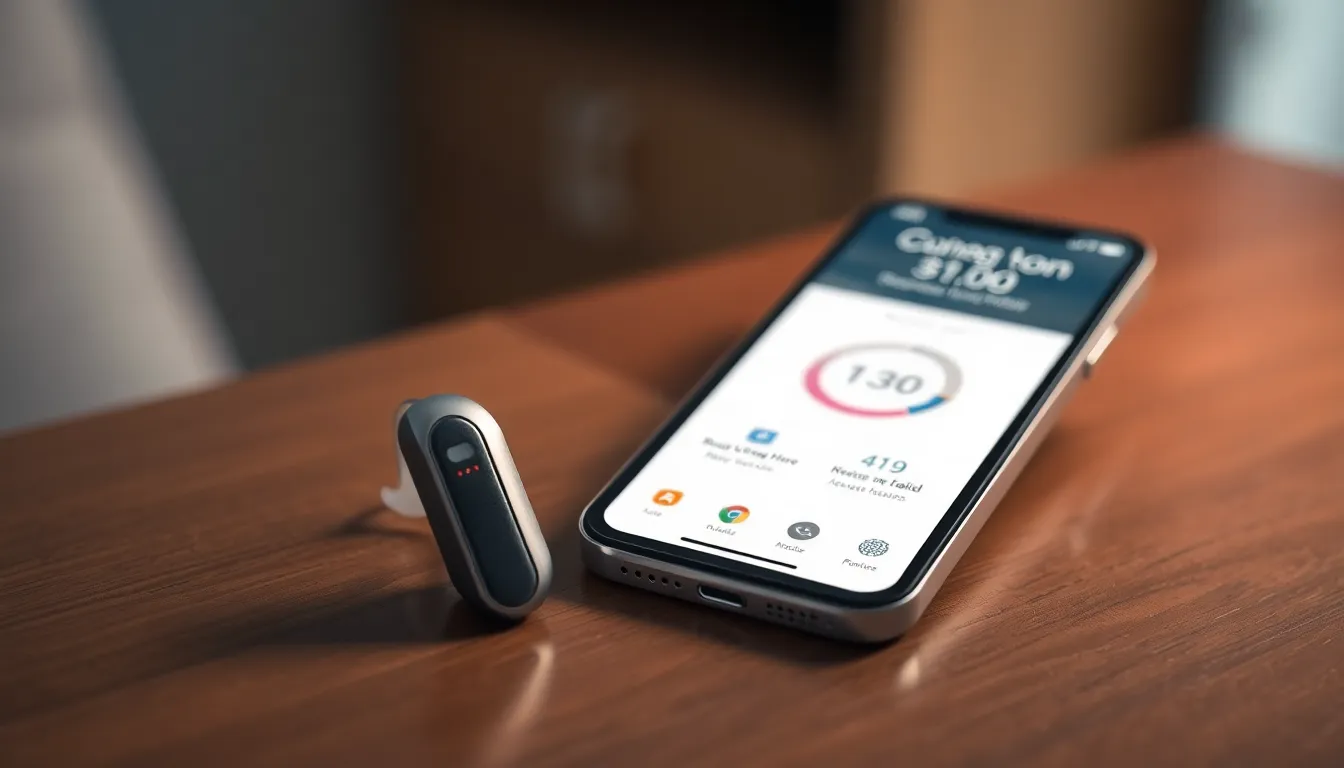Imagine a world where hearing loss doesn’t mean missing out on life’s best moments. Smart hearing aids are revolutionizing the way people experience sound, blending cutting-edge technology with everyday convenience. These little devices do more than amplify sound; they adapt to environments, filter background noise, and even connect to smartphones.
Gone are the days of clunky gadgets that scream, “I’m old!” Instead, these sleek wonders fit seamlessly into modern life, proving that staying connected is just as important for the ears as it is for the eyes. With smart hearing aids, users can enjoy crystal-clear conversations and rediscover the joy of music—all while looking effortlessly stylish. So, whether it’s a family gathering or a concert, smart hearing aids are here to ensure no one misses a beat.
Table of Contents
ToggleOverview of Smart Hearing Aids
Smart hearing aids represent a significant advancement in auditory technology, designed to enhance the lives of individuals with hearing loss. These devices utilize sophisticated algorithms to amplify sound, ensuring that users capture essential audio details more clearly. They adapt seamlessly to different environments, automatically adjusting settings to optimize listening experiences.
Environmental factors play a crucial role in hearing. Smart hearing aids possess the capability to filter out unwanted background noise, allowing users to focus on conversations, music, or any desired sounds. Users appreciate this feature, as it creates a comfortable auditory environment. Connectivity options further enhance these devices, enabling users to link their hearing aids to smartphones and other Bluetooth-enabled gadgets.
Modern aesthetics characterize the design of smart hearing aids. Sleek, discreet profiles ensure that users remain stylish while benefiting from improved hearing capabilities. Various styles cater to individual preferences, making it easier for users to find a suitable match.
Compatibility with mobile apps significantly enhances user control. Individuals can adjust volume levels, switch between listening programs, and monitor battery life directly from their smartphones. Regular software updates maintain device performance and introduce new features.
Data collected from smart hearing aids can also provide valuable insights about hearing habits, informing users and audiologists for better personalized care. With the integration of features like built-in microphones and advanced sound processing, these devices empower individuals to fully engage in conversations and important life moments.
Features and Benefits

Smart hearing aids provide a variety of features benefiting users with hearing loss. These devices not only amplify sound but also adapt seamlessly to different environments, enhancing audio clarity and user experience.
Advanced Technology Integration
Advanced technology powers smart hearing aids. They incorporate sophisticated algorithms that dynamically adjust sound amplification based on environmental factors. Built-in microphones capture sound from various sources, enabling superior sound processing. This technology filters out distracting background noise, allowing for clarity during conversations. They also connect to smartphones, transforming calls and music into high-quality audio experiences. Compatibility with mobile apps grants control over settings and adjustments in real time.
Personalization and Customization
Personalization stands as a key feature of smart hearing aids. Users customize listening profiles to suit individual preferences and needs. Adaptive technology tailors sound settings based on personal hearing habits and preferences, creating a unique auditory experience. Regular software updates introduce new features, ensuring continual enhancement and user satisfaction. Data collected aids audiologists in providing tailored recommendations for improved hearing care. Overall, personalization encourages users to engage fully with their surroundings, enhancing communication and enjoyment.
Types of Smart Hearing Aids
Smart hearing aids come in various configurations, each designed to cater to specific needs and preferences. Understanding the differences helps users choose the right one for their lifestyle.
Behind-the-Ear (BTE) Models
BTE models feature a small case that rests behind the ear, connected to a custom earpiece by a thin tube. These devices accommodate a range of hearing losses, making them versatile choices. Many users appreciate their durability, as BTE models often house more powerful amplifiers. The larger design allows for longer battery life, reducing the frequency of replacements. Connectivity options like Bluetooth enable seamless streaming from smartphones and other devices. BTE styles remain discreet or can be customized in various colors, appealing to different aesthetics.
In-the-Ear (ITE) Models
ITE models fit directly in the outer ear and come in varying sizes to match individual ear shapes. A compact design enables users to enjoy a more discreet appearance without sacrificing features. Advanced ITE technology supports functions such as noise cancellation and automatic adjustments based on environmental sounds. Users often find them comfortable for extended wear due to custom fittings that ensure a secure fit. Offering a range of colors, ITE models appeal to individuals seeking both functionality and style. Enhanced connectivity allows for adjustments and music streaming, improving the overall user experience.
Comparison with Traditional Hearing Aids
Smart hearing aids significantly differ from traditional hearing aids in functionality. Traditional devices primarily amplify sound, lacking the adaptive features found in smart models. Users often struggle with background noise in various environments when using standard aids, while smart hearing aids dynamically filter out unwanted sounds.
In terms of connectivity, traditional hearing aids typically operate independently, while smart hearing aids integrate seamlessly with smartphones and other devices. Such connectivity allows users to adjust settings easily through mobile apps, enhancing the overall auditory experience in real-time.
Cost is another aspect where distinctions arise. Smart hearing aids generally come with a higher price tag because of their advanced technology, though users benefit from superior sound processing and customization. Traditional options usually represent a more budget-friendly choice, but they limit personalization and smart features.
Battery life also plays a crucial role in the comparison. Many traditional hearing aids use disposable batteries, which can add up in long-term costs and maintenance. Smart hearing aids often feature rechargeable batteries, offering convenience and sustainability. Users appreciate not needing frequent battery replacements while enjoying enhanced functionalities.
The user experience shapes preferences significantly. Traditional devices may feel cumbersome in social situations due to their simplistic design and limited performance. In contrast, smart hearing aids empower users to engage more fully in conversations, thanks to their advanced sound processing abilities.
Lastly, the potential for personalization stands out. Traditional hearing aids generally lack the capability for ongoing updates, whereas smart hearing aids receive regular software updates that enhance functionality and introduce new features. Data collection from smart devices aids audiologists in tailoring care, providing a more tailored hearing experience.
User Experience and Reviews
User experiences with smart hearing aids reflect significant satisfaction. Many users report improved clarity in conversations, especially in challenging environments. Feedback highlights the smoothing of background noise, enabling listeners to focus on important sounds without distractions.
Advanced features play a crucial role in these positive reviews. Users appreciate the ability to connect seamlessly to smartphones for streaming music or taking calls. This connectivity not only enhances functionality but also promotes a modern lifestyle, making these devices more attractive.
Customization stands out as another key benefit. Users can adjust settings based on individual preferences, often through user-friendly mobile apps. This flexibility allows individuals to tailor their auditory experience to suit various situations, such as social gatherings or quiet moments at home.
Battery life also receives high marks from users. Smart hearing aids often feature rechargeable options, leading to lower maintenance costs and fewer hassles with replacing disposable batteries. Many individuals value this convenience, finding it simplifies their daily routines.
Reviewers consistently note the stylish designs of smart hearing aids. Aesthetic appeal combined with advanced technology makes them an appealing choice for many. Desiring both function and form, users appreciate that these devices can complement their personal style.
Smart hearing aids differ notably from traditional models, improving overall usability. Users notice fewer issues with feedback noise, enhancing comfort during extended wear. Enhanced software updates continually enrich the user experience, pushing the boundaries of what these devices can achieve.
Data collected from user interactions helps refine and optimize the performance of smart hearing aids further. This data-driven approach demonstrates a commitment to personalized care, ensuring users feel valued and heard.
Smart hearing aids represent a significant leap forward in hearing technology. With their ability to adapt to various environments and filter out background noise they empower users to engage more fully in life. The integration with smartphones enhances usability making it easier for individuals to control their auditory experience.
Personalization remains a key feature allowing users to tailor settings to their unique preferences. This adaptability not only improves communication but also enriches social interactions. As technology continues to evolve smart hearing aids will likely become even more sophisticated offering users an unparalleled auditory experience. Embracing these advancements can lead to a more connected and fulfilling lifestyle for those with hearing loss.



